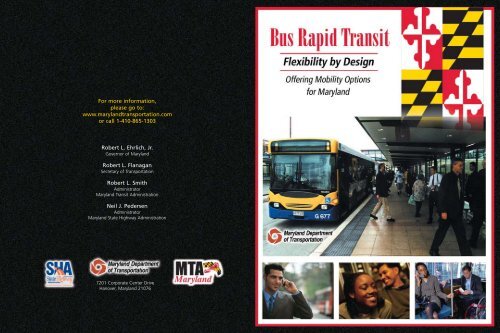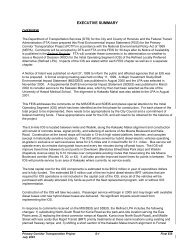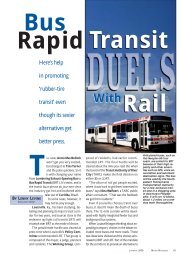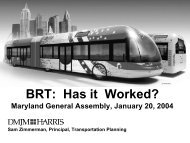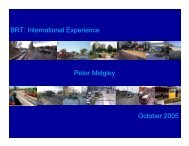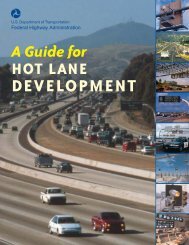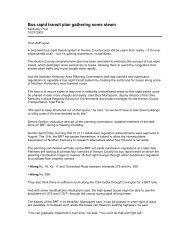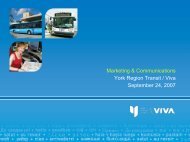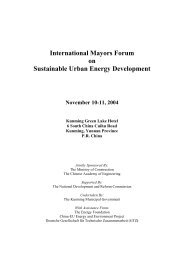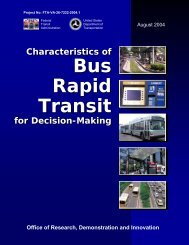State of Maryland BRT Brochure - Bus Rapid Transit Policy Center
State of Maryland BRT Brochure - Bus Rapid Transit Policy Center
State of Maryland BRT Brochure - Bus Rapid Transit Policy Center
You also want an ePaper? Increase the reach of your titles
YUMPU automatically turns print PDFs into web optimized ePapers that Google loves.
<strong>BRT</strong> <strong>Brochure</strong>.qxd 10/11/04 12:17 PM Page 2For more information,please go to:www.marylandtransportation.comor call 1-410-865-1303Robert L. Ehrlich, Jr.Governor <strong>of</strong> <strong>Maryland</strong>Robert L. FlanaganSecretary <strong>of</strong> TransportationRobert L. SmithAdministrator<strong>Maryland</strong> <strong>Transit</strong> AdministrationNeil J. PedersenAdministrator<strong>Maryland</strong> <strong>State</strong> Highway Administration7201 Corporate <strong>Center</strong> DriveHanover, <strong>Maryland</strong> 21076
<strong>BRT</strong> <strong>Brochure</strong>.qxd 10/11/04 12:18 PM Page 4The Ehrlich Administration has made a promise to <strong>Maryland</strong>'s residentsand businesses to make tangible, near-term transportation improvementsthroughout the <strong>State</strong> in order to achieve Governor Ehrlich's vision <strong>of</strong> aMore Mobile <strong>Maryland</strong>. The <strong>State</strong>'s transportation agencies are committedto easing the congestion that clogs our highways and constrains ourtransit services.<strong>Maryland</strong> faces a number <strong>of</strong> challenges inproviding the best possible transportationoptions. There are competing demands forfunds due to a backlog <strong>of</strong> unfunded butimportant transportation projects – somedeferred for a decade or more. This posesa hurdle for tackling congestion statewide,including in the critical I-270 TechnologyCorridor, on arterial highways in and out <strong>of</strong>D.C. and Baltimore, in the I-95 corridor, andthroughout Southern <strong>Maryland</strong>.To help address traffic congestion and improvecustomer service, the <strong>Maryland</strong> Department <strong>of</strong>Transportation (MDOT), <strong>Maryland</strong> <strong>Transit</strong>Administration (MTA), and <strong>Maryland</strong> <strong>State</strong>Highway Administration (SHA) are consideringa new approach – <strong>Bus</strong> <strong>Rapid</strong> <strong>Transit</strong> (<strong>BRT</strong>).<strong>BRT</strong> – Combining the ServiceQuality <strong>of</strong> Rail with theFlexibility <strong>of</strong> <strong>Bus</strong>esConventional bus and rail transit already play a vitalrole in <strong>Maryland</strong>'s transportation network. <strong>Transit</strong> servicereduces congestion, assists with efficient land use, supportseconomic development, and provides transportationaccess and mobility for the young, elderly, disabled,and those who do not own an automobile.<strong>Bus</strong> <strong>Rapid</strong> <strong>Transit</strong> encompasses a variety <strong>of</strong>approaches designed to improve travel speed,reliability, and quality <strong>of</strong> transit services. In generalterms, a <strong>BRT</strong> system is an integrated rapid transit systemthat combines the quality <strong>of</strong> rail with the flexibility<strong>of</strong> buses.<strong>Bus</strong> <strong>Rapid</strong> <strong>Transit</strong> is not a one-size-fits-all solution,but rather a family <strong>of</strong> approaches that share commonPrinciples <strong>of</strong> <strong>Bus</strong><strong>Rapid</strong> <strong>Transit</strong>■ Move people as effectively asrail at a potentially lower initialcapital cost■ Fully utilize existing roadways,rights-<strong>of</strong>-way, and station sites■ Take advantage <strong>of</strong> availabletechnology (e.g., automatic vehiclelocation, passenger information,signal priority, and “Smart Card”type fare collection)■ Apply incremental systemdevelopment, based ondemand and funding■ Maximize operating flexibility■ Change the mindset for bustransit – from conventionalbus fleet operations to state-<strong>of</strong>the-arttransit systems that areconvenient, reliable, attractive,and comfortablefeatures or principles. <strong>BRT</strong> solutions range from <strong>BRT</strong>vehicles operating in general-purpose travel laneswith preferential access and “queue jumping” attraffic signals, to full-fledged integrated systemsoperating in exclusive "running ways." There is afull continuum <strong>of</strong> <strong>BRT</strong> approaches between thesetwo extremes.<strong>Bus</strong> <strong>Rapid</strong> <strong>Transit</strong> systems may incorporatestreamlined fare collection techniques, suchas pre-pay systems, further supporting quickerboarding and exiting, as well as use <strong>of</strong> advancedinformation systems to improvecustomer convenience, speed,reliability, and safety.Common <strong>BRT</strong> componentsare explained more fully onpages 4 and 5.2 3
<strong>BRT</strong> <strong>Brochure</strong>.qxd 10/11/04 12:18 PM Page 6Components <strong>of</strong> a <strong>Bus</strong> <strong>Rapid</strong><strong>Transit</strong> SystemA <strong>BRT</strong> system combines flexible service and newtechnologies to improve customer convenienceand reduce delays. While specific <strong>BRT</strong> applicationsvary, the components may include:Running Ways – exclusive guideways ordedicated lanes that allow <strong>BRT</strong> vehiclesto be free <strong>of</strong> conflicting automobiletraffic, parked or stopped vehicles, andother obstructions – maximizing <strong>BRT</strong>operating speeds. In some situations,<strong>BRT</strong> vehicles also may operate in generaltraffic, trading speed and reliability forflexibility. "Queue jumper" is a termthat refers to short exclusive lanes atsignalized intersections that are usedto allow <strong>BRT</strong> vehicles to jump to thehead <strong>of</strong> the line and bypass stoppedautomobiles and traffic.Vehicles – modern, low-floor, highcapacity rubber-tired vehicles thataccommodate high volumes <strong>of</strong> ridersand fast boarding and exiting. <strong>BRT</strong>vehicles <strong>of</strong>ten use clean fuels oralternative power.Stations – ranging from protectedshelters to large transit centers, <strong>BRT</strong>stations are located within the communitiesthey serve and provide easy access tothe system.Route Structure and Schedule –established to maximize direct, no-transferrides to multiple destinations and to createmore flexible and continuous service(reducing the need for a schedule)for local and express bus service.Fare Collection – designed to make it fastand easy to pay, <strong>of</strong>ten before boarding thevehicle, <strong>BRT</strong> fare collection systems includethe use <strong>of</strong> self-service pro<strong>of</strong>-<strong>of</strong>-paymentsystems or pre-paid stored-value farecards, such as a "Smart Card" system.Advanced Technology – the use <strong>of</strong> advanced technologies (or IntelligentTransportation Systems) to improve customer convenience, speed, reliability, andsafety. Examples include systems that provide traffic signal preference for busesat intersections and cross streets, as well as Global Positioning Systems (GPS) toprovide passenger information such as real-time bus arrival information.Source: Adapted from Transportation Research Board – <strong>Transit</strong> Cooperative Research Program,4<strong>Bus</strong> <strong>Rapid</strong> <strong>Transit</strong> – Why More Communities are Choosing <strong>Bus</strong> <strong>Rapid</strong> <strong>Transit</strong>, 2001.5
<strong>BRT</strong> <strong>Brochure</strong>.qxd 10/11/04 12:19 PM Page 8Capturing the Benefits <strong>of</strong> <strong>Bus</strong><strong>Rapid</strong> <strong>Transit</strong><strong>Bus</strong> <strong>Rapid</strong> <strong>Transit</strong> systems share many <strong>of</strong> the benefits<strong>of</strong> conventional bus and rail systems but also have anumber <strong>of</strong> unique benefits.For commuters and other travelers:■ An easier commute – By providing frequentservice into neighborhoods and commercial areas,<strong>BRT</strong> systems can minimize walking and reducethe need for transfers from one mode to another(e.g., from bus to rail or automobile to bus or rail).Pre-boarding fare collection systems, such as theone shown in the photo on page 7, provide quickand easy access for commuters.■ A fast and reliable travel time – When operatingin exclusive running ways or dedicated lanes, <strong>BRT</strong>systems can run at faster speeds than conventionalbuses in regular traffic and even as fast as lightrail. By <strong>of</strong>fering frequent service and avoidingtraffic-related delays, <strong>BRT</strong> systems can provideriders with a more reliable travel time.■ A more enjoyable trip – <strong>BRT</strong> systems generallyuse rubber-tired, low-floor vehicles with widedoorways and aisles that are easy to board andcomfortable to ride, as shown in the photo below.In some instances, <strong>BRT</strong> vehicles are designed toprovide premium seating and amenities such asthose found on a commuter train or commercialvan or bus.For the transportationsystem and the <strong>State</strong>:■ A potentially less expensive transitalternative – Depending on the specific systemdesign, <strong>BRT</strong> capital costs can be lower thanlight rail systems with similar capacity andservice level.■ A quicker solution – Based on a combination<strong>of</strong> design, construction, and cost factors, <strong>BRT</strong>systems can <strong>of</strong>ten be brought online fasterthan comparable rail systems. Also, because<strong>BRT</strong> systems can be implemented in stages asdemand grows and funds become available,they <strong>of</strong>fer an opportunity for incrementalsystem development.■ An opportunity to take advantage <strong>of</strong>underutilized rights-<strong>of</strong>-way – Like light rail,<strong>BRT</strong> systems can take advantage <strong>of</strong> existingrights-<strong>of</strong>-way and areas for stations to maximizethe efficiency <strong>of</strong> transportation solutions andminimize community and environmental impacts.■ Community enhancements andeconomic development – Accompanied bycomplementary land use and zoning policies,<strong>BRT</strong> systems can encourage compact, pedestrianandtransit-friendly developments that areintegrated into the surrounding area.■ Operating flexibility – Depending on thesystem design, <strong>BRT</strong> systems <strong>of</strong>fer operationalflexibility generally not afforded by rail systems,such as the ability to temporarily re-route <strong>BRT</strong>vehicles from dedicated lanes to general trafficlanes based on system conditions. And, <strong>BRT</strong> canoperate express and local service on the samerunning way by having bypass lanes at stations.■ A means to increase transit ridership inselect corridors – By making high-quality transitservice more accessible and customer-friendly,<strong>BRT</strong> has the potential to increase overall transitridership. It also can work as an impetus toincrease ridership on other parts <strong>of</strong> thetransit system.By taking advantage <strong>of</strong> the principles <strong>of</strong> <strong>Bus</strong> <strong>Rapid</strong><strong>Transit</strong> (described on page 3), <strong>BRT</strong> can achievemany important benefits for individuals using thesystem – i.e., fast, dependable, and convenientservice – and for the <strong>State</strong>, a lower cost, moreexpedient solution to tackling congestion insome locations.Quick Compare –<strong>BRT</strong> vs. Conventional <strong>Bus</strong>and Light Rail SystemsFollowing is a quick synopsis <strong>of</strong> the generalcomparison factors between <strong>BRT</strong> and conventionalbus and light rail. In reality, these service typesmight be used as complementary services in anoverall, integrated transportation system.<strong>BRT</strong> vs. Conventional <strong>Bus</strong> ServiceFactor <strong>Bus</strong> <strong>Rapid</strong> <strong>Transit</strong> Conventional <strong>Bus</strong>Lower Upfront CostSpeed / ReliabilityOperating FlexibilityNeighborhoodPenetrationComfort / AmenitiesCarrying Capacity✔✔✔Both have considerableoperating flexibility✔✔<strong>BRT</strong> vs. Light Rail ServiceFactor <strong>Bus</strong> <strong>Rapid</strong> <strong>Transit</strong> Light RailLower Upfront CostSpeed / ReliabilityOperating FlexibilityNeighborhoodPenetrationComfort / AmenitiesCarrying Capacity✔Studies show <strong>BRT</strong> can equal LRT speedsand reliability✔✔Can be similarStudies show this to be similar■ Environmental stewardshipopportunities – Through the use <strong>of</strong> cleanand alternative fuel vehicles and the reductionin automobile traffic and congestion, <strong>BRT</strong>systems can help achieve air quality and otherenvironmental goals.6 7
<strong>BRT</strong> <strong>Brochure</strong>.qxd 10/11/04 12:19 PM Page 10Learning from Experiences inOther CommunitiesThe entire <strong>BRT</strong> system will provide 20 stationsalong seven miles. Current ridership is 80 percenthigher than the predecessor conventional bus service.Exploring <strong>BRT</strong> Opportunitiesin <strong>Maryland</strong><strong>Bus</strong> <strong>Rapid</strong> <strong>Transit</strong> is being considered in a number<strong>of</strong> locations throughout <strong>Maryland</strong>. Project developmentstudies are underway in the following corridors:■ Bi-County <strong>Transit</strong>way – A 14-mile corridorin Montgomery and Prince George's Countiesconnecting Bethesda, Silver Spring, TakomaPark/Langley Park, College Park, and NewCarrollton. Exclusive running way and mixedflow (lanes shared with general traffic) <strong>BRT</strong>alternatives are being studied.■ Red Line in Baltimore – A study for this 10-mileBaltimore City and County corridor is evaluatingexclusive and mixed flow <strong>BRT</strong> alternatives. Thepurpose is to provide better mobility in the eastwestcorridor from Woodlawn, to downtownBaltimore, to Fells Point and Patterson Park.■ Green Line in Baltimore – A study for this 4-mileBaltimore City corridor is evaluating exclusiveand mixed flow <strong>BRT</strong> alternatives that wouldextend transit service from downtown Baltimoreto northeast suburbs in the vicinity <strong>of</strong> Morgan<strong>State</strong> University and Good Samaritan Hospital.■ I-270/US 15 Corridor – This study is evaluatingtwo alternatives for <strong>BRT</strong> service: one along theCorridor Cities <strong>Transit</strong>way as an exclusive runningway from the Shady Grove Metro Station toClarksburg, and the second Express <strong>Bus</strong> transitservice within existing HOV and proposedExpress Toll Lanes along I-270.The <strong>State</strong> <strong>of</strong> <strong>Maryland</strong> and local communities arebeginning to consider <strong>BRT</strong> as part <strong>of</strong> the solution ina number <strong>of</strong> other corridors throughout the <strong>State</strong>.<strong>BRT</strong> is by no means the only solution being considered,but rather one tool in the expanding toolboxto help address the <strong>State</strong>'s transportation needs.Based in part on strong support from the federalgovernment, the <strong>BRT</strong> concept is taking <strong>of</strong>f as analternative to be considered in a diverse range <strong>of</strong>locations and to address a variety <strong>of</strong> service needs.National studies have concluded that <strong>BRT</strong>works – it can attract new riders, encouragetransit-oriented development, be cost-effective,and, in many instances, provide greater operatingflexibility than rail transit and better servicethan conventional bus systems. The vast majority<strong>of</strong> new, fully-integrated <strong>BRT</strong> systems have experiencedthe same type <strong>of</strong> ridership increases previously thoughtto be achievable only by rail transit.While still a relatively new and evolving concept, <strong>BRT</strong>systems have been successfully designed, built, andnow operated in a number <strong>of</strong> locations within theUnited <strong>State</strong>s and worldwide. Following are just afew examples.Silver Line – Boston, MassachusettsAn example <strong>of</strong> <strong>BRT</strong> in an urban corridor andconnected to other transit services – much likewhat is being considered for the Green andRed Lines in Baltimore.The Silver Line, Boston, MassachusettesThe Massachusetts Bay <strong>Transit</strong> Authority's (MBTA)new Silver Line is a <strong>BRT</strong> service connecting historicRoxbury to downtown Boston. The Silver Line usesdedicated transit lanes as well as mixed trafficoperation. The MBTA also is constructing tunnels toprovide direct connections to the subway, commuterrail, Amtrak, intercity bus, and Logan Airport.A state-<strong>of</strong>-the-art Intelligent Transportation Systemis planned to improve mobility, safety, efficiency,and customer service by collecting real-time datatransmitted from Silver Line vehicles. Using GlobalPositioning System satellites, the system will trackbus locations and enable the MBTA's Control <strong>Center</strong>to respond to changing route conditions. Thisinformation also will be transmitted to digital messageboards and "smart" kiosks at Silver Line stations.Pittsburgh, Pennsylvania <strong>Bus</strong>ways<strong>Bus</strong>ways – Pittsburgh, PennsylvaniaAn example <strong>of</strong> <strong>BRT</strong> commuter service –similar to what is being considered forthe I-270/US 15 Corridor.The Port Authority <strong>of</strong> Allegheny Countyoperates a series <strong>of</strong> busways, providing18 miles <strong>of</strong> fast, reliable rapid transitservice to downtown Pittsburgh. Easypedestrian access, feeder services (buses andvans that bring riders to the busway system),and park-and-ride lots make it easy for commutersto leave their cars and ride into town. Within thecity, <strong>BRT</strong> vehicles exit the busways and use citystreets to deliver passengers to their destinations.The Pittsburgh <strong>Bus</strong>ways use direct connections intopark-and-ride lots to improve travel time. In addition,the corridors take advantage <strong>of</strong> right-<strong>of</strong>-wayadjacent to existing rail lines.Ontario <strong>Transit</strong>way –Ottawa, OntarioThe Ontario <strong>Transit</strong>way, Ottawa, OntarioAn example <strong>of</strong> an integrated <strong>BRT</strong> systemusing available rights-<strong>of</strong>-way and operatingin a combination <strong>of</strong> dedicated and mixedtraffic environments – with some elementssimilar to the Bi-County <strong>Transit</strong>way.The Ontario <strong>Transit</strong>way is a 20-mile systemconstructed primarily on rail rights-<strong>of</strong>-way, aswell as exclusive bus lanes on city streets and aregional highway. A portion <strong>of</strong> the system (South<strong>Transit</strong>way) serves a very high-density residentialcorridor with stations every ½ - 1 mile. In thedowntown area, buses use bus-only curbsidelanes to load and unload passengers. Ottawa<strong>of</strong>fers its users in-line stations with pedestrianoverpasses to avoid conflicts with the highvolumes <strong>of</strong> buses. Stations are integrated intotheir setting such as downtown business districtsor suburban shopping malls.8 9
<strong>BRT</strong> <strong>Brochure</strong>.qxd 10/11/04 12:20 PM Page 12<strong>Bus</strong> <strong>Rapid</strong> <strong>Transit</strong> <strong>of</strong>fers a way to rethink transitservice – merging the service benefits <strong>of</strong> rail withthe cost-effectiveness and flexibility <strong>of</strong> conventionalbus service. <strong>BRT</strong> systems can be developed asstand-alone transit service or as part <strong>of</strong> anintegrated transit system. <strong>Bus</strong> <strong>Rapid</strong> <strong>Transit</strong>,therefore, is one <strong>of</strong> a number <strong>of</strong> strategies beingconsidered to address near- and longer-term traveldemand, improve customer service, and expeditetransportation improvements.<strong>Maryland</strong> transportation agencies are consideringthe role <strong>BRT</strong> can play throughout the <strong>State</strong> andbelieve that the concept holds considerablepromise. <strong>BRT</strong>'s flexibility – the ability to tailorservices to meet specific local needs as well asits potential lower upfront cost and thus quickerimplementation – could help build transit ridershipin targeted corridors and help address the <strong>State</strong>'scongestion challenge.FREQUENTLY ASKEDQUESTIONSQ:A:What are the differencesbetween LRT and <strong>BRT</strong>?<strong>BRT</strong> is sometimes referred to as a"rubber-tired Light Rail <strong>Transit</strong> (LRT) system"but with greater operating flexibility andpotentially lower costs. <strong>BRT</strong> has some <strong>of</strong>the benefits <strong>of</strong> LRT at a fraction <strong>of</strong> theupfront capital cost. Key operationaldifferences, however, include: the use <strong>of</strong>rubber-tired vehicles rather than rail cars;flexibility to take vehicles <strong>of</strong>f dedicatedlanes and into general traffic; better localaccess to stations for transit riders; andless need for transfers and multiple modes<strong>of</strong> transportation to complete a trip.Q:A:Q:A:What are the costs<strong>of</strong> constructing andmaintaining <strong>BRT</strong>?Capital costs <strong>of</strong> <strong>BRT</strong> are generally thoughtto be less than those for light rail. The actualcosts <strong>of</strong> each individual system, however,depend on the local conditions and contextin which the system will be operated. Capitalitems include the running way (busways orbus lanes), stations, park-and-ride facilities,communications and improved traffic signalsystems, storage and maintenance facilities,and vehicles.Like the capital costs, <strong>BRT</strong> operating costsvary and are dependent on factors such asthe number and type <strong>of</strong> vehicles operated,service frequency, and number <strong>of</strong> stops.How is <strong>BRT</strong> differentfrom a city bus?<strong>BRT</strong> systems incorporate elements from bothbus and rail. Key differences from city buses,however, include use <strong>of</strong> dedicated transitwaysor lanes for at least a portion <strong>of</strong> the route,vehicle design that provides easier and fasterboarding and exiting, greater use <strong>of</strong> hybridelectric power, and stations within neighborhoodsthat provide not only shelter but a widerange <strong>of</strong> additional services and amenities.Q:A:Q:A:Will the <strong>BRT</strong> vehicleget stuck in traffic?<strong>BRT</strong> may rely on separated, dedicated lanesor access to HOV or Express Toll Lanes thatare shared with toll-paying automobiletraffic. In this way, <strong>BRT</strong> vehicles are able toprovide reliable travel to many destinations.Could you convert a <strong>BRT</strong> toLRT or Metro at some point?Yes. <strong>BRT</strong> systems may be designed to beconverted to rail service at a future date –as ridership increases and funding is secured.Seattle, Washington, for example, is pursuinga partial conversion <strong>of</strong> its bus tunnel systemto allow for shared use by both bus andlight rail. The Seattle <strong>Bus</strong> Tunnel is onesegment <strong>of</strong> a regional <strong>BRT</strong> system that alsoincludes a network <strong>of</strong> exclusive transitwaysand HOV lanes.Q:A:Are people more likelyto take rail than bus?By incorporating many <strong>of</strong> the serviceamenities <strong>of</strong> rail with the added convenience<strong>of</strong> nearby, neighborhood-friendly stations,<strong>BRT</strong> has proven its ability to attract theridership levels previously thought to bepossible only with rail systems.Q:A:Will <strong>BRT</strong> service stopin my neighborhood?Because <strong>BRT</strong> systems generallyare able to provide more stopsin locations that are withinneighborhoods than railsystems, there is a muchgreater likelihood that serviceis directly accessible in yourneighborhood – or withinwalking distance <strong>of</strong> it.10 11


